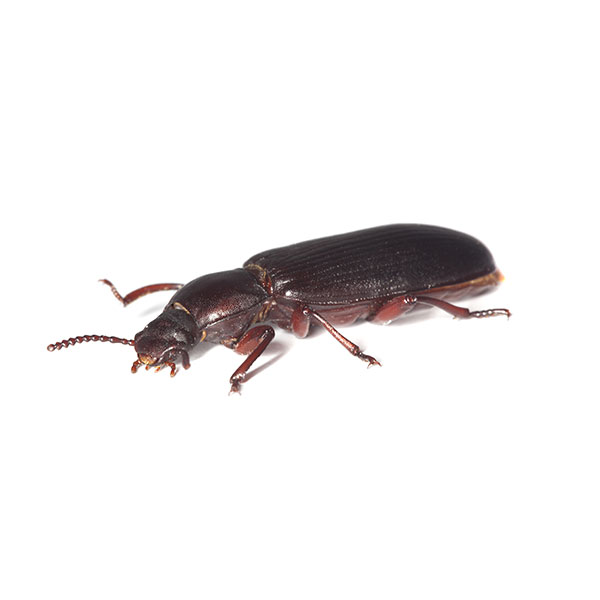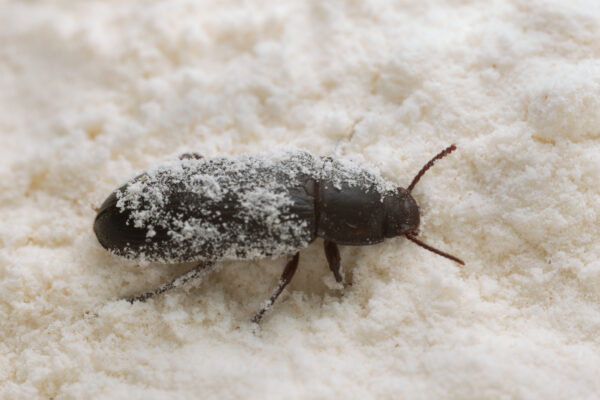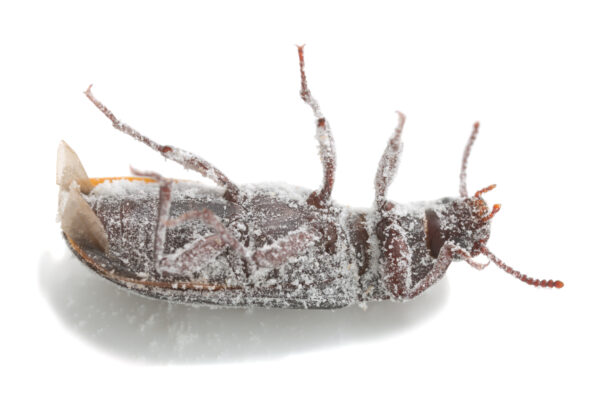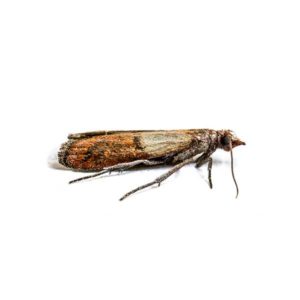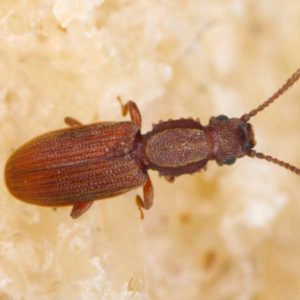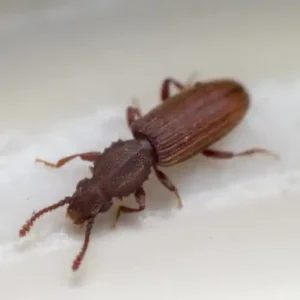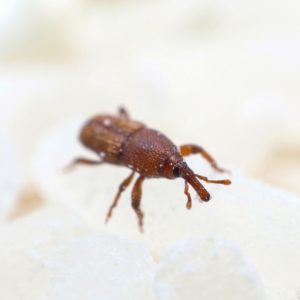What Are Confused Flour Beetles?
A number of beetles infest flour and grain-based products and are collectively referred to as flour beetles. Among these, the confused flour beetle (Tribolium confusum) and the red flour beetle are two of the most economically damaging species. Confused flour beetles are particularly common in the northern regions of the United States and are notorious for their ability to infest processed grain products. These beetles are omnivorous, feeding on a variety of plant and animal matter.
Confused flour beetles are small, reddish-brown insects measuring about 3–4 millimeters in length. Their bodies are slender, with a smooth exoskeleton, and they are often mistaken for the closely related red flour beetle due to their similar appearance. One distinguishing feature is their antennae, which gradually enlarge toward the tip, forming a four-segmented club. Unlike red flour beetles, confused flour beetles are unable to fly.
Flour beetles are critical pests of flour and processed grain, frequently encountered in flour mills, food storage facilities, and even household kitchens. They thrive in environments with a steady supply of grain dust, milled cereals, and other processed grain products. Due to their widespread presence and adaptability, confused flour beetles are one of the most common pantry pests, often causing significant economic losses in food production and storage.
What Habitats Are Confused Flour Beetles Found In?
The confused and red flour beetles live in the same environments and often compete for resources. Flour beetles are commonly found inside infested grain products and in cracks or crevices where grain or food particles may have spilled. These pests infest a wide range of products, including cereal, cake mix, cornmeal, crackers, dry pet food, chocolate, nuts, and seeds like birdseed. Both adult beetles and their small, off-white larvae can be found in infested food items. Adult beetles frequently wander away from the source of infestation, appearing in pantries, cupboards, and other areas of the home.
Confused flour beetles are particularly attracted to environments where food products are improperly stored or where food particles accumulate. They thrive in warm, dark spaces with easy access to spilled grain, flour, or processed food, such as pantry shelves, storage containers, or cracks in kitchen floors and walls. High moisture content in grain products can further attract these beetles, as it creates an ideal environment for mold growth, which they may also feed on. These beetles’ ability to survive in a wide range of processed foods and their tendency to explore beyond infested items make them a persistent challenge for households and food storage facilities alike.
How Does An Infestation of Confused Flour Beetles Begin?
Confused flour beetles are attracted to certain smells and food sources that encourage them to enter homes and create infestations. These pests are particularly drawn to:
- The scent of aging grains or cereals, especially those with high moisture content.
- Cracks in improperly sealed food packaging include cardboard boxes and thin plastic bags.
Once inside a home, adult beetles lay eggs directly in or near food sources. The larvae hatch and begin feeding on the food material, which sustains them through their development. As the infestation grows, adult beetles may wander away from the initial food source, spreading the problem throughout pantries and cupboards.
Their small size and ability to hide in tight spaces allow them to spread unnoticed until significant contamination has occurred. Monitoring stored food for signs of activity and maintaining proper storage practices are essential to preventing infestations.
Are Confused Flour Beetles Dangerous?
Confused flour beetles do not bite or spread disease, but they pose significant risks to the quality of food and food safety. The primary danger lies in their ability to contaminate food supplies. As they infest stored grain products, they can leave behind tiny feces, body parts, and webbing, leading to food contamination. This not only makes the food unappetizing but also potentially unsafe to consume. Additionally, the presence of these beetles encourages mold growth on grain, further degrading the food’s quality and may cause it to spoil faster.
Common signs of food contamination include small holes or tears in food packaging, particularly in flour or cereal products, with visible bits of meal or grain spilling out. If you notice beetles crawling or flying around your pantry or kitchen, it’s a sign that an infestation is likely present. Infested food may also have a distinctive, unpleasant odor, which is another clear indication that your food has been compromised. If you find signs of an infestation in your pantry, it’s essential to immediately discard all affected food. Be sure to check all nearby food items, as these beetles can spread quickly, and food products without obvious infestations may still be at risk
If an infestation is present in your Florida home, locate and discard all infested material. Contact your local pantry pest control experts for help or advice with confused flour beetles!
What Is The Life Cycle of The Confused Flour Beetle?
The confused flour beetle’s life cycle consists of four stages: egg, larva, pupa, and adult. Depending on environmental conditions, this cycle typically spans six to ten weeks.
- Egg Stage:
Female confused flour beetles lay their eggs directly in food products, with each female capable of producing up to 500 eggs in her lifetime. The eggs are small, white, and challenging to see with the naked eye. - Larva Stage:
The larvae are cream-colored and worm-like, feeding voraciously on the infested material. This stage lasts approximately two to four weeks. - Pupa Stage:
After feeding, the larvae pupate, forming a protective casing. This stage lasts about a week as the beetles transition into adults. - Adult Stage:
Adult beetles emerge from the pupae and begin reproducing within days. They can live for several months, continuing the cycle and potentially leading to large infestations.
Managing an infestation can be difficult without professional expertise, especially when these pests spread throughout your pantry or food storage areas. Pantry pest control offers specialized solutions designed to disrupt the life cycle of confused flour beetles and prevent future infestations.
How To Prevent Confused Flour Beetles
Preventing confused flour beetles starts with proper food storage and awareness of how these pests enter your home. Store grains, cereals, and other dry goods in airtight containers made of glass or heavy plastic to prevent access. Always inspect food products for signs of infestation before purchasing or storing them, as these beetles often make their way into homes through infested items from the store. Keeping your pantry and cupboards clean is essential—spilled grains, food dust, or crumbs can attract these pests and provide a breeding ground.
You can also use pheromone traps to monitor for signs of pantry pests and seal cracks and crevices in storage areas to reduce potential hiding spots. For an added layer of prevention, freeze grains and flours for several days before storing them, which helps kill any eggs or larvae present. Despite these measures, infestations can sometimes be challenging to handle on your own. Contact our pantry pest experts for advice and professional treatment if you suspect you are dealing with confused flour beetles.
Need help with Confused Flour beetles?
We'll call you! Leave your information below.
Frequently Asked Questions
Why Is It Called A Confused Flour Beetle?
The confused flour beetle gets its name because it is difficult to distinguish it from the red flour beetle. These two species are extremely similar in appearance, leading to frequent confusion during identification.
What Is The Difference Between Red Beetles And Confused Flour Beetles?
The main difference lies in their ability to fly. While red flour beetles are capable of flight, confused flour beetles cannot fly. Additionally, their antennae have subtle differences—red flour beetles have a three-segmented club at the end of their antennae, whereas confused flour beetles have a four-segmented club.
What Are Confused Flour Beetles Attracted To?
Flour beetles are drawn to aging grains, grain dust, and processed grain products with high moisture content. Damaged or improperly sealed packaging is another common attractant, as it provides easy access to food sources.
How Do Confused Flour Beetles Get In Flour?
Flour beetles infest flour and grain products by laying eggs during storage or processing. These eggs hatch into larvae, which develop into adults, leading to a complete infestation. Infested products are often unknowingly transported into homes from stores.
Are Confused Flour Beetles More Active At Night?
Yes, flour beetles are primarily nocturnal and tend to be more active at night. Their nocturnal nature often makes it difficult to spot them during the day unless their infestation is severe.

